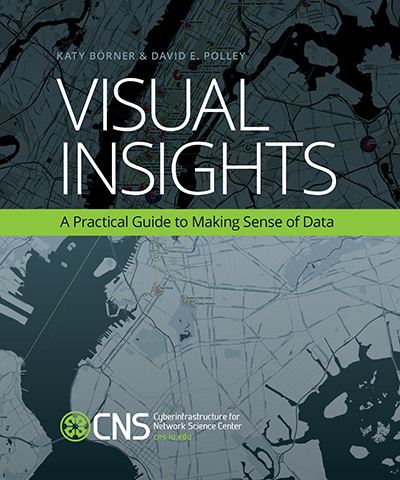Readings

Visual Insights
Katy Börner and Ted Polley
Visual Insights: A Practical Guide to Making Sense of Data was created as a companion textbook to the course. It offers a gentle introduction to the design of insightful visualizations, seamlessly blending theory and practice to give readers both the theoretical foundation and the practical skills to render data into insights. Each chapter has a hands-on section that demonstrates how plug-and-play macroscope tools can be used to run advanced data mining and visualization algorithms. The final two chapters present exemplary case studies and discuss future developments. Click here to learn more about the book and see a preview.

Atlas of Science: Visualizing What We Know
Katy Börner
Atlas of Science by Katy Börner, based on the popular exhibit, "Places & Spaces: Mapping Science," describes and displays successful mapping techniques. The heart of the book is a visual feast: Claudius Ptolemy's Cosmographia World Map from 1482; a guide to a PhD thesis that resembles a subway map; "the structure of science" as revealed in a map of citation relationships in papers published in 2002; a visual periodic table; a history flow visualization of the Wikipedia article on abortion; a globe showing the worldwide distribution of patents; a forecast of earthquake risk; hands-on science maps for kids; and many more. Each entry includes the story behind the map and biographies of its makers.

Atlas of Knowledge: Anyone Can Map
Katy Börner
Drawing on 15 years of research and tool development, the Atlas of Knowledge introduces a theoretical visualization framework meant to empower anyone to systematically render data into insights. It aims to teach “timeless” knowledge that holds true over a lifetime while referring to an extensive set of references for “timely” advice on what tool and workflow is currently the best for answering a specific question. Specifically, the visualization framework uses a systems science approach to cover major types and levels of analysis; it identifies and explains different types of insight needs, data scales, visualizations, graphic symbols, and graphic variables; and it deeply integrates statistical, geospatial, topical, and network analysis and visualization.

Sci2 Manual
Scott Weingart, Ted Polley et al
The Science of Science (Sci2) Tool is a modular toolset specifically designed for the study of science. It supports the temporal, geospatial, topical, and network analysis and visualization of datasets at the micro (individual), meso (local), and macro (global) levels. Users of the tool can: access science datasets online or load their own; perform different types of analysis with the most effective algorithms available; use different visualizations to interactively explore and understand specific datasets; share datasets and algorithms across scientific boundaries. Click here to access the manual.
Announcements
Class starts on January 9, 2018.